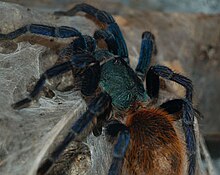Greenbottle blue tarantula
This article needs additional citations for verification. (June 2009) |
| Greenbottle blue tarantula | |
|---|---|

| |
| Scientific classification | |
| Domain: | Eukaryota |
| Kingdom: | Animalia |
| Phylum: | Arthropoda |
| Subphylum: | Chelicerata |
| Class: | Arachnida |
| Order: | Araneae |
| Infraorder: | Mygalomorphae |
| Family: | Theraphosidae |
| Genus: | Chromatopelma Schmidt, 1995[1] |
| Species: | C. cyaneopubescens
|
| Binomial name | |
| Chromatopelma cyaneopubescens | |
Chromatopelma is a genus of spiders in the family Theraphosidae (tarantulas), with the sole species Chromatopelma cyaneopubescens.[1] A native of the Paraguaná peninsula, Venezuela, it is known as the greenbottle blue tarantula, and has some of the most dramatic colouring of any spider species. Adult greenbottles have metallic blue legs, a blue-green carapace and a vibrant orange abdomen.
They are very active, fast-growing and particularly attractive to tarantula hobbyists.
Taxonomy
The species was first described by Embrik Strand in 1907, as Eurypelma cyaneopubescens. (Eurypelma is now considered to be a synonym of Avicularia.) It was moved to the newly created genus Delopelma by Alexander Petrunkevitch in 1939. (Delopelma is now considered to be a synonym of Aphonopelma.) Gunter Schmidt in 1995 considered the species sufficiently distinct to warrant a new genus, Chromatopelma.[1] The genus name refers to the "beautiful blue colour" of C. cyaneopubescens.[2]
Schmidt differentiated Chromatopelma from Aphonopelma based on the scopulae of the tarsus of the third leg and the metatarsus and tarsus of the fourth leg being divided by bristles (setae); the very large posterior median eyes; and the single fused spermatheca of the female.[2]
Natural habitat
These tarantulas live in webbed burrows under bushes and tree roots in desert areas of northern Venezuela, in Paraguana. The entrance is often extended with webbing, sometimes resembling a funnel shape. These webs may protect the entrance from the harsh desert climate, also acting as a trap for insects. They can also be found near the city of Punto Fijo in towns and rural places.
In captivity
In captivity, this tarantula regularly renews the webbing of its burrow, commonly filling the entire container. It feeds frequently and is a fast-grower. While many are skittish and nervous, some individuals are calm and docile, though running very quickly when disturbed. For this reason it is not recommended for handling, as a fall may be more likely if it were startled compared to other slower tarantula species. Some, when disturbed, are very possessive and show threat displays guarding their burrows. These species are voracious feeders and young spiders will even take food as big as themselves, this makes them fun to observe and makes it an ideal beginner tarantula.
